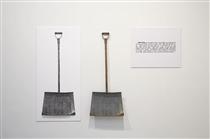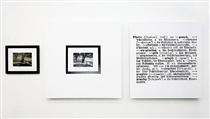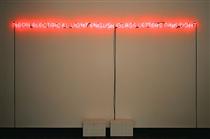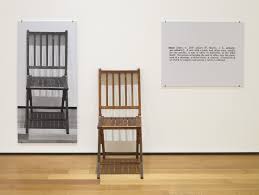
1945
Joseph Kosuth

description
Joseph Kosuth is an American contemporary artist, one of the pioneers and a vivid representative of Conceptual art. He is known throughout the world for his installations; in particular, his composition “One and Three Chairs” has become a classic example of the style. As a 23-year-old student, he received a grant from the Cassandra Foundation with the “blessing” of master Marcel Duchamp to implement his innovative ideas.
The artist was the first to deeply explore the relations between ideas, images, and words used to describe them. He used words instead of visual images of any other kind, that is, he completely excluded objects in order to focus on the meaning conveyed exclusively by the language. The awards given to the artist most eloquently speak of the recognition of Joseph Kosuth’s unique talent. The main ones are the Brandeis and Frederic Weisman Prizes, the Menzione d’Onore at the Venice Biennale, the title of Cavalier from the French government, the highest award of the Republic of Austria for achievements in science and culture. Since 2014, the neon installation of Kosuth is a part of a permanent exhibition at the Paris Louvre.
Many of the installations of Kosuth included excerpts from literature and works on philosophy and psychology. The quotes are filled with an important universal meaning – this is how the artist makes his audience reflect on the problems of personal identity, poverty and racism, loneliness and the lessons of history. Avoiding any clear or too explicit comments of his own, Joseph Kosuth realizes himself both as a modern artist, philosopher and moralist.
Key ideas:
– Joseph Kosuth believed that images and any other kinds of artistic mastery should be excluded from art. Only under such a condition can ideas be transmitted “purely”: as directly and immediately as possible. There should not be any obstacles to the expression of ideas; according to the innovator, any image is just an obstacle. This postulate became one of the main forces that made Conceptual art an independent movement in the late 1960s.
– The artist studied the relations between words, their meanings, and how they relate to objects and things that they describe. He was fascinated by the ideas of philosopher Ludwig Wittgenstein about language and fascinated by the relationship between visual and linguistic. His search for the relationship between literature and art took the form of installations, museum exhibitions, social events, performances and publications throughout Europe, America and Asia.
– In his fundamental essay “Art after philosophy” published in 1969, Kosuth argued, “Art is a continuation of philosophy.” The artist also became interested in the works of Z. Freud and created several works using his texts, as well as the works of Nietzsche, Claude Levy-Strauss and others.
– Joseph Kosuth’s appeal to art devoid of all morphological features is an intellectual provocation, as a result of which words replaced images and objects.
1945
1955
1963
1965
1967
1969
1970
1972
1975
1978
1981
1990
1993
1999
2003
2007
2013
The birth of the artist
Visited the Design School of the Museum of Toledo

Entered the Cleveland Art Institute

Moved to New York and attended the School of Visual Arts

Founded the Museum of Normal Art in New York

Fifteen Locations

Held a personal exhibition at the Leo Castelli Gallery

Studied anthropology and philosophy at the New York New School of Social Research

Became co-editor of the short-lived Fox magazine

Worked as an art editor at Marxist Perspectives

Started to use the theories of Sigmund Freud

He was awarded the Brandeis Prize

Was awarded by Menzione d'Onore at the Venice Biennale

The exhibitions in Naples, Istanbul, Munich and Dublin

Received the highest award for his merits from the Republic of Austria

"Language of equilibrium"

«ni apparence ni illusion»

Joseph Kosuth
On Artist
flow
Concept art
Happening
Fluxus
friends
Lawrence Weiner
Roger Catfort
artists
Marcel Duchamp
Joseph Boyce
Robert Rauschenberg
Yves Klein
Marina Abramovich
By Artist
flow
Concept art
friends
Lawrence Weiner
Robert Barry
artists
Barbara Kruger
Ilya Kabakov
Damien Hirst
Nam June Pike
Bruce Nauman
Jenny Holzer
